Today I worked on a Japanese Black pine. It was grown from seed about 10 years ago and I kept it because it has a really good 360 degrees root system that should develop into great pine nebari. Despite having such a great root system the top has not developed particularly well so I have not given it much attention so it is a good candidate to show how I go about making initial styling decisions.At workshops, club meetings and shows I hear many bonsai growers express frustration about not being able to make initial styling decisions and I can remember the same experiences myself. If you are one of those who have difficulty deciding what to do with a tree these ideas may help.
I find it very helpful to follow a structured analysis of the trees attributes.
- Roots: Good surface roots give your bonsai a feeling of stability so they are quite important. Scrape away enough potting mix to expose the surface roots. Sometimes the first roots you find are small and spindly so keep going until you start to see stronger roots. Look at the roots from all round the tree and mark the side that shows the roots best.
- Trunk: A strong trunk will give a good first impression so look at the trunk from all sides and from different angles. Note which sides give the best view of the bends and curves.
- Branching: A bonsai generally looks best if it has lowest side branches coming slightly forward to give depth to the design. Occasional back branches are important to give further depth. Thicker low branches and thinner near the top give a better image of a tree. Look at the branching from all round the tree to see if you can find some spots that give good views of the existing branches. (Keep in mind that some branches can be removed if necessary)
- Features: Look for any aspects that stand out on the tree. Things that you want others to see and enjoy. Dead wood or hollows in the trunk may be features. Strong bends or twists may be worth showing off. Excellent root structure could be included as a feature. Note which side(s) of the tree allow any features to be seen best. Don’t worry if you can’t identify any special features. Many immature stock plants do not have anything really special.
- Faults: Finally, identify aspects you don’t like. On some trees scars or dead parts may not be desirable. Awkward bends may not look attractive. Reverse taper can distract the viewer’s eye so is usually seen as a fault. Again, try looking at the tree from different sides and different angles to see if there are places which minimise or hide any faults. As with features, your tree may not have any real faults which can actually make the next step even easier.
Putting it together: Now try to match the best views of each of the above steps. It is rare for a tree to have all the best features in one view so you will probably need to compromise a bit to find the overall best side of your tree – The best view of branches and roots may give the second best view of the trunk or maybe to hide a particularly bad fault you’ll have to accept a less than best view of the trunk. Remember you may be able to deal with some faults by removing them. That’s why we have cutters and saws.
We also need to take into account the relative importance of these features for different species. Nebari is far less important but trunk shape is considered more important in junipers so give more weight to trunk when assessing a juniper. A really good nebari is highly valued on broadleaf deciduous species, particularly maples so we may chose a less attractive trunk to show the best nebari views. It is relatively quick and easy to grow new branches on maples so we might choose the best view of the nebari and trunk in a maple even though branch placement is poor and elect to remove all branches and grow new ones from the resulting shoots.
Let’s try applying these evaluation techniques to my pine.
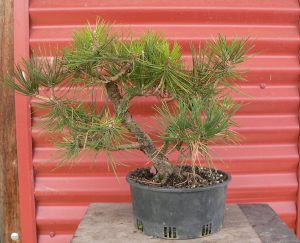
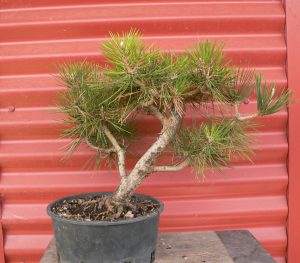
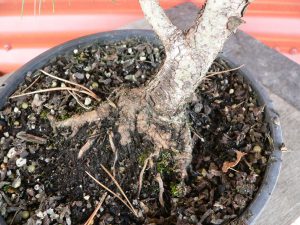 Roots: Good roots all round the trunk. Nebari is slightly wider where the trunk leans to ether side.
Roots: Good roots all round the trunk. Nebari is slightly wider where the trunk leans to ether side.
Trunk: Emerges at an angle which looks best where the tree leans to one side or the other. Not good where tree leans back or forward.
Branches: 2 strong, low branches. First branch has long, bare areas and starts very low on the trunk. One upper branch has some good bends and plenty of smaller side branches – branch X
Features: Potential nebari is a feature on this tree.
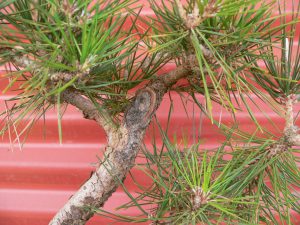 Faults: (Plenty of these on this tree) Trunk is quite stiff and straight. Very little taper in the trunk. Large scar near the top of the trunk.
Faults: (Plenty of these on this tree) Trunk is quite stiff and straight. Very little taper in the trunk. Large scar near the top of the trunk.
Putting it all together and making decisions: Because the roots are good from all sides they probably won’t influence my choices today. Trunk looks best when leaning to either side so best views are here – Side A
 and here – Side B
and here – Side B
From this side the trunk bows slightly forward before bending away.
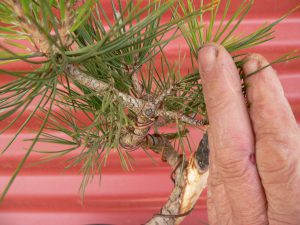 This upper branch is attractive but leans strongly. From one side it leans toward the back which rarely gives a satisfactory impression in bonsai. This branch is thin and flexible enough to move with wire but I doubt I can bring it right over toward side A so side B becomes a preferred option.
This upper branch is attractive but leans strongly. From one side it leans toward the back which rarely gives a satisfactory impression in bonsai. This branch is thin and flexible enough to move with wire but I doubt I can bring it right over toward side A so side B becomes a preferred option.
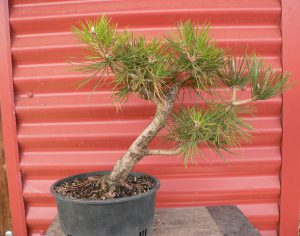 The lowest branch could be used to fill the space on the left almost as a second trunk but I think it will look better with some open space here so I’ve removed that branch.
The lowest branch could be used to fill the space on the left almost as a second trunk but I think it will look better with some open space here so I’ve removed that branch.
Dealing with the faults: From either side the straight trunk and lack of taper is very visible and cannot be hidden from view. Scar is hidden when viewed from side A.
Converting faults into features:
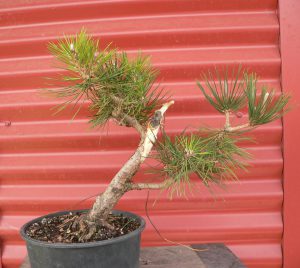 By reducing the trunk back to the good branch and using that branch as the new apex, both taper and movement will be improved.
By reducing the trunk back to the good branch and using that branch as the new apex, both taper and movement will be improved.
Converting the upper trunk to jin will add another feature to the tree. The existing scar may even be incorporated into the jin as additional feature.
Extending the shari down from the jin it will further enhance the taper of the trunk.
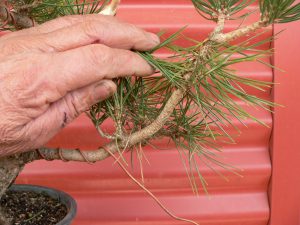 The lower branch has a long, bare part with 2 smaller shoots at the base so it is easy to reduce the length and improve the taper of that branch.
The lower branch has a long, bare part with 2 smaller shoots at the base so it is easy to reduce the length and improve the taper of that branch.
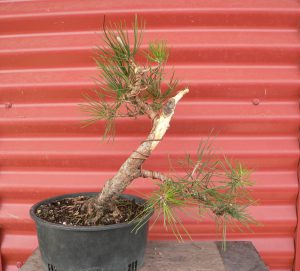 The new apex leans quite strongly toward the new front so It is wired and bent into a more upright position.
The new apex leans quite strongly toward the new front so It is wired and bent into a more upright position.
The lower trunk still leans forward slightly before moving away from the viewer.
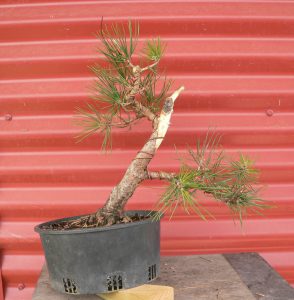 Tilting the whole tree back slightly will not only change that for the better but also gives a slightly better view of the new apex.
Tilting the whole tree back slightly will not only change that for the better but also gives a slightly better view of the new apex.
I’m still having second thoughts about that lowest branch. It is quite low and is still rather straight and therefore at odds with the strong bends in the new upper trunk. The tall, thin feel of this trunk will also probably be enhanced by less branching rather than more.
For the moment I’ll leave it. As a sacrifice branch it will add weight to the lower trunk over the next couple of years as I develop ramification.
You can see that this pine still has quite a long way to go before it deserves a place at a bonsai show but I think today’s work has taken it another step forward.
